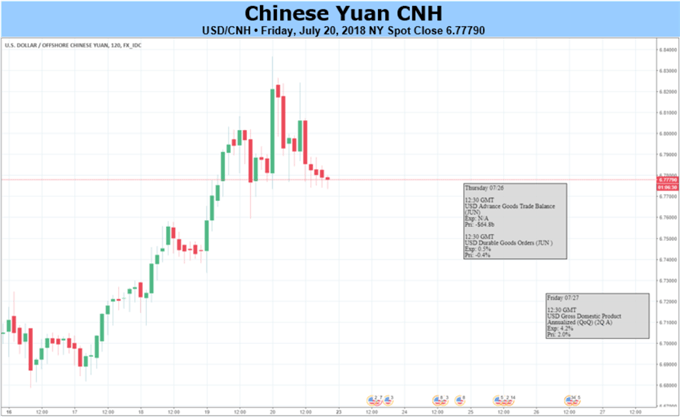
FUNDAMENTAL FORECAST FOR CNH: BEARISH
- China’s Central Bank seems to have shifted its opinion on the Yuan to more weakness.
- The falling risk appetite and slow economic growth provide limited support to the Yuan.
- Chinese equities remain vulnerable amid United States’ threat of additional tariffs.
How to trade news? Learn with DailyFX Free Trading Guides!
THE CHINESE YUAN
The Chinese Yuan lost against all the G10 currencies this week. The USD/CNH touched 6.8362, the weakest level for the Yuan in more than a year. Also, the PBOC, which set a reference rate of the currency on a daily basis, confirmed Yuan’s falling against the U.S. Dollar: The so-called daily fixing dropped -1.4% over the past week; on Friday alone, it declined -0.9%. Looking forward the PBOC’s guidance will continue to be a top driver to the Yuan.
The top policymaker seems to have shifted its view towards the Chinese currency over the past three weeks. On July 3, five PBOC officials commented on the currency, ahead of the deadline of US tariffs on $34 billion Chinese products. Following the remarks, the falling Yuan paused at around 6.70. However, the daily fixing set by the regulator, was weaker than the forecast calculated by Caixin news with PBOC’s formula. This may be because a relatively weak Yuan could help to make up some Chinese exporters ‘losses caused by US tariffs, amid the on-going US-China trade war.
Also, the falling risk appetite may have contributed to Yuan’s selling and could continue to. In addition, China’s economy expanded at a slower pace in the second quarter, as expected yet hinting uncertainties in the future; the Yuan lacks support from fundamentals. Taking into account all these above, Yuan’s outlook in the medium term remains to be bearish. In the immediate term, a too-fast dropping Yuan could have side effects; thus, the PBOC may guide its pace and is worth to watchclosely.
CHINESE EQUITES
One major side effect of a weak Yuan is its impact to the Chinese stock market. Equities may not necessarily fall with the Yuan – the Shanghai Composite Index closed on Friday slightly lower than in last week. However, the Chinese stock indices are unlikely to reverse the current downtrend, with the Yuan tumbling. This is because a weak Yuan could drag down a significant amount of companies’ stock prices.
In specific, airlines shares have been hurt the most amid the falling Yuan. Since early June, the stock prices of the top Chinese airlines have plunged over -20%; two out of the three lost more than -30%. The Yuan weakness could benefit textile and apparel exporters that have not been impacted by US tariffs yet. However, as the US President Trump threatened to impose additional duties on all Chinese imports, the outlook of these shares is still uncertain.
-- Written by Renee Mu, Currency Analyst with DailyFX







